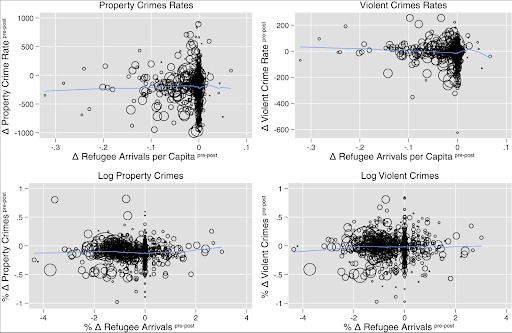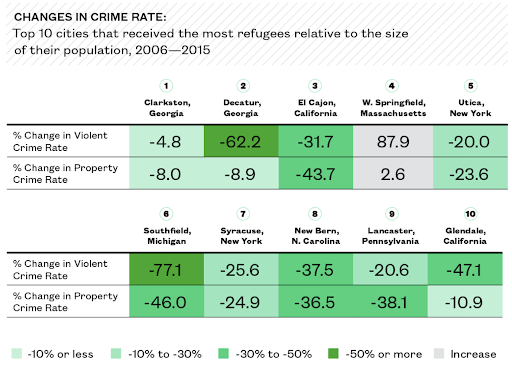In January 2017, President Trump signed Protecting the Nation from Terrorist Entry into the United States, an executive order dramatically reducing refugee resettlement. Referred to as the “travel ban” or “Muslim ban” by critics, the sudden policy change reversed decades of U.S. immigration policy. In part due to unfounded fears that refugees increase crime rates and pose a national security threat, the policy resulted in the lowest number of resettled refugees in a decade and a 65.6 percent decrease in resettlement from 2016 to 2017.
The Trump Administration’s rhetoric conflated immigration and crime and sparked a national shift away from supporting immigration. In a poll released this month, more than half of Americans claimed that there is an ongoing “invasion” at the Southern border, in tune with the national shift away from pro-immigration.
The presumption was that when a large number of refugees arrive in a region, crime rises in subsequent years, and placing limits on immigration would drastically decrease crime rates. In actuality, there was a null effect on crime rates in response to changes in refugee resettlement rates brought by the 2017 ban.
The association between crime and immigration is not new. In 2017, 45 percent of Americans agreed that immigrants exacerbate crime. Particularly within the GOP, the topic of immigration has served as key campaign fodder – 71 percent of Republicans believe that immigrants worsen crime rates, as opposed to 34 percent of Democrats. Given that refugees are painted in one light by the broader community – individuals escaping war, poverty, and persecution, Americans seem to expect they possess a relatively high inclination to commit violent crime.Despite a 65.6 percent drop in refugee resettlement, there was no visible effect on various types of crime, according to findings from a University of Cambridge study on the relationship between crime and refugee resettlement after the ban’s implementation.

The study plots the relationship between 2015-2016 to 2017-2018 changes in refugee arrivals and present-day policy changes in crime rates along the blue regression line. If less refugee resettlement led to lower crime rates, we would witness a downward sloping regression line. Across both types of crimes (left versus right plots) and when measured in rates and logs (top versus bottom plots), there is no apparent correlation between the reduction in refugee arrivals due to the ban and subsequent changes in local crime rates. The findings suggest that crime rates would have been similar had refugee arrivals continued at pre-Executive Order levels.
Likewise, examining crime data from ten U.S. cities that received the most refugees relative to their population size between 2006-2015 reveal that rather than crime rising, nine out of ten cities became considerably safer. As seen in the figure below, Southfield, Michigan, experienced a whopping 77.1 percent drop in violence crime rates. The only city in this study that experienced increased crime was Springfield, Massachusetts, but it is important to note that an opioid epidemic impacted Springfield during that period.

Ultimately, restricting refugee resettlement to the U.S. proved to be an ineffective policy tool for reducing crime for many reasons. Firstly, the selection process for refugees in the U.S. adopts a vulnerability-based approach – a system that prioritizes admitting people with injuries or other forms of hardship.
It is unlikely that admitted refugees are, on average, more inclined to commit crime than the general populace. Second, resettled refugees arrive in such small numbers compared to the overall population that they do not have the statistical capacity to impact local crime rates. Third, the demographic composition of refugees coming to the U.S. is not historically the most crime-prone demographic. Young men are the most prone to crime, but less than 14 percent of refugees resettled in 2016 were young males.
As there is no plausible link between refugee resettlement and crime, the new administration is trying to reverse President Trump’s refugee policy. In May 2021, President Biden revised the annual refugee admissions ceiling to 62,500 for the remainder of the year, and in October, he set the ceiling for 2022 to 125,000 after four years of record-low numbers under Trump. But there still exists a huge discrepancy between the ceiling targets and the number of admitted refugees. Though the annual resettlement ceiling for 2021 was revised to 62,500, only 11,411 refugees were admitted. In 2022, the Biden administration has yet to come close to its goal of 125,000.
Despite the Biden administration lagging behind their goals, the ceiling uptick proves promising and is encouraging that the attitude around refugee admission has shifted in a positive direction. Ideally, that shift will be more readily reflected in the number of refugees admitted into the country.
Photo credit: iStock